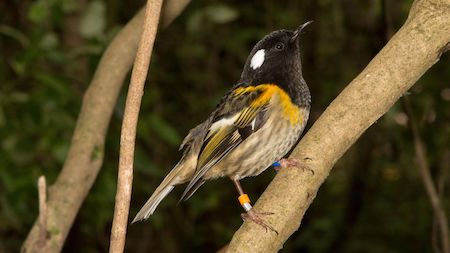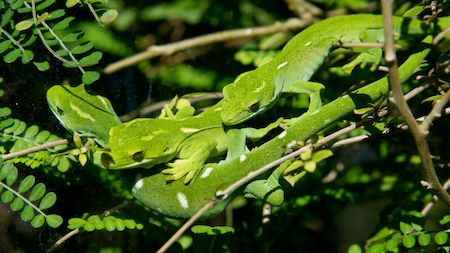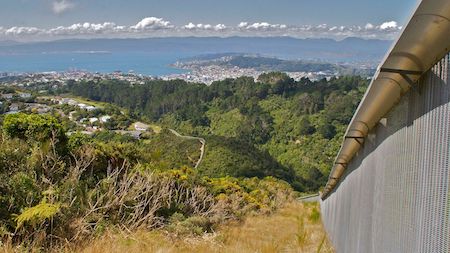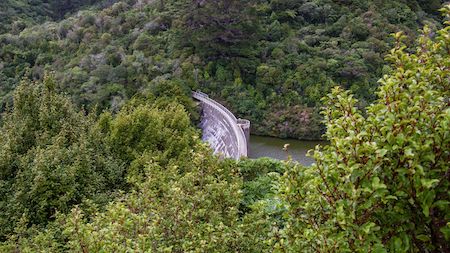In the past 30 years, a wilderness has grown up in the heart of New Zealand's capital – so successfully its neighbours now complain about the raucous racket of rare birds. But this is just the first step in a much longer plan for wilderness in the city. As I walk along a winding trail through Zealandia, an ecosanctuary in New Zealand's capital city of Wellington, I smell the wet earth from last night's rain, hear birds cackle and sing, and feel a slight chill from the cool breeze. Then, I see it: a streak of yellow landing on a tree branch high above. It's a stitchbird – a sparrow-sized songbird whose Māori name, hihi, refers to the rays of the sun. One of New Zealand's rarest birds, the hihi is a success story for Zealandia, which houses the largest mainland population of around 100 adults. Hihi are considered a threatened species, disappearing from the mainland in the 1880s and confining themselves to Little Barrier Island off the north-eastern coast of New Zealand's North Island. In 2005, they were translocated to Zealandia, where they have been breeding successfully each year. Aside from housing over 40 native bird species, Zealandia is also home to dozens of critically endangered reptiles, frogs and invertebrates, as well as hundreds of native plants and trees. Yet unlike many ecosanctuaries located on an offshore island, in a forest or in a rural environment, Zealandia is situated in a valley in Karori, a suburb only 10 minutes' drive from New Zealand's parliament.
Evidence of the benefits of green spaces in cities abound – from improving physical and mental health and well-being to absorbing carbon, mitigating floods and reducing the heat island effect. Urban green spaces become even more vital as two-thirds of the world's population will likely be living in cities by 2050, while 87% of New Zealand's population already lives in urban areas. "As we become more urbanised, we need to connect people to nature," says Margaret Stanley, an ecologist and associate professor in the School of Biological Sciences at the University of Auckland. "The more they connect with nature, the more they value it." Zealandia's rich biodiversity can be attributed to the 5.3-mile (8.6km) predator-exclusion fence encircling 225 hectares (556 acres) of land. A group of conservation managers, engineers and scientists designed and tested a fence suitable to Zealandia's needs – one high enough to prevent invasive mammalian predators such as ferrets and possums from jumping or climbing over, with a wire mesh wall to exclude pests down to the size of a mouse and an underground skirt to prevent rats and other animals from burrowing underneath. After the fence's construction in 1999, pest eradication followed, with Zealandia declared predator-free a year later. Since then, a number of flora and fauna have been reintroduced or naturally grown in the ecosanctuary. "By creating an area that excludes all introduced mammalian predators, we've created a safe haven," says Paul Atkins, Zealandia's chief executive. "And what we've seen is a rapid increase in the population of these birds that had been previously on the edge of extinction from the [Wellington] region."
Zealandia is a perfect example of a living laboratory that can be a boon for conservation research, even within cities. "It's a place where restoration techniques can be trialled, which is important for advancing conservation management outside of these areas," Stanley says. "It's also an accessible way for the public to see research in action." And because they're a dedicated space for plants and animals to grow and thrive, ecosanctuaries are easier to protect and manage. They're also a purposeful way to experience nature in urban areas. "When people walk around their neighbourhoods, they might see trees or hear birds, but they don't always think about that moment as experiencing nature, so it becomes passive," says Kiri Joy Wallace, an urban ecologist and research fellow in the Environmental Research Institute at the University of Waikato in New Zealand. "With ecosanctuaries, you go to that pocket of nature and actively experience it." Yet not all cities are equipped to build fenced-in areas, as they may not have such expansive green spaces or the time, money and resources to transform these spaces into nature reserves and keep them predator-free. "Instead of fenced areas, plan for corridors of vegetation throughout the city, so nature is dispersed and not contained in one place," Stanley says. "By doing that, you're not only increasing biodiversity in the city, but you're also connecting communities that don't have access to nature." This is especially true for underserved communities that historically have less vegetation in their neighbourhoods, or low-income residents who might not be able to afford the entrance fees. Spreading nature across the city also avoids the isolating effect ecosanctuaries tend to have. "You're reinforcing this idea that nature is separate from people," Wallace says. "And the benefits we get are constrained to just that one spot, which people only experience when they visit or live around it."
Today, regular maintenance of Zealandia's fence continues, including monitoring for mice and occasional incursions from animals such as weasels and stoats. Restoring the sanctuary's ecosystem still remains a priority, ensuring all species within will flourish and thrive. But Zealandia is turning its efforts outward, moving beyond the fence and engaging communities around the greater Wellington region – where more than 200,000 New Zealanders live, or 8% of the country’s population – with its education programmes that inspire nature-based learning experiences for schools, internships, professional development for science teachers and volunteer opportunities. "A big part of Zealandia's success is that it's embedded in the community," says Ellen Irwin, lead ranger in Zealandia's conservation team. "We've got hundreds of volunteers coming in almost every day, feeding the birds and checking the fence daily, making sure there's no tree fall or anything that might let a mammalian predator in. The ecosanctuary wouldn't function without them." Zealandia also assists with responsible predator-trapping initiatives and educates people on planting native trees, whose fruits and flowers nourish native birds. "The sanctuary provides a safe space for species to breed and thrive, but the trapping and planting efforts of local community groups make it a team effort of folks across Wellington wanting to make it a more biodiverse city," Irwin says. "You could have birds leaving the sanctuary, but if they don't have good habitats and safe places to go, then they're not going to survive." This spillover of birds from nature reserves to urban areas is a positive outcome, yet it also poses a challenge for cities, especially in New Zealand where people haven't had to live with these species. For instance, people have complained about kākā, an at-risk parrot destroying their homes, or the raucous singing of tūī, a honeyeater with a distinctive tuft of white feathers on its throat.
"I see it as a sign of success when people complain that birdsong is too loud. But now that this wildlife has started to interact with our homes, it's brought up this idea of human-wildlife conflict," says Stanley. "Conservation in cities has to start with individuals and communities because everything you do affects nature in cities. The next step is to encourage behaviour change in the way people interact with nature." For cities wanting to follow in Zealandia's footsteps, Atkins advises to find the right starting point ecologically, then get the community involved in restoring that. Zealandia itself began as farmed and mined land before the construction of a dam in 1878 which supplied water to Wellington. As a critical water supply, the land around the valley was protected and allowed to regrow, making it easier to convert into a nature reserve once the dam was decommissioned in 1997. "What we didn't start with was a bare paddock. We had an ecosystem that was damaged but not desolate," Atkins says. "Find a green space that's capable of being regenerated, where you can see quick signals of that regeneration so you have immediate evidence of your work, and restore it together with your community.”
Looking to the future, Zealandia has a 500-year vision of restoring the forest and freshwater ecosystems of the valley where it resides as closely as possible to their prehuman state. This five-century period is the sanctuary's estimate of how long it would take for the forest's original canopy to regrow. Some species of rātā trees, for instance, can live up to a thousand years, while hardwood trees like rimu have a life span of between 550 and 650 years. For it to be enduring, we have to get people involved and committed to an intergenerational view – Paul Atkins Bringing this vision to life is daunting and challenging, but a mindset shift is key. "The moment you recognise the intergenerational aspect of your work is the moment you realise you have to treat it differently than another enterprise that might be here for only 10 years," Atkins says. "It makes you think about how to plan from year to year to ensure the security of that 500-year view, and set up exemplars of what can be done to mitigate, reverse or help solve the issues we might be facing in the next 100, 200 or 500 years." It's a far-off and bold target, but Zealandia's long-term vision plays an essential role in the sanctuary's current and future success. "For it to be enduring, we have to get people involved and committed to an intergenerational view, where we are stewards and not owners," says Atkins. "It's not just a function of how long it takes a tree to grow – it's also a function of how we need to behave if we're going to make sustainable change." Source URL |





